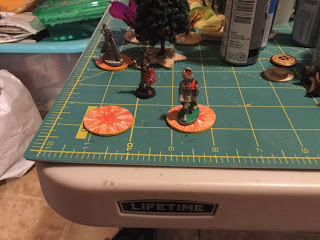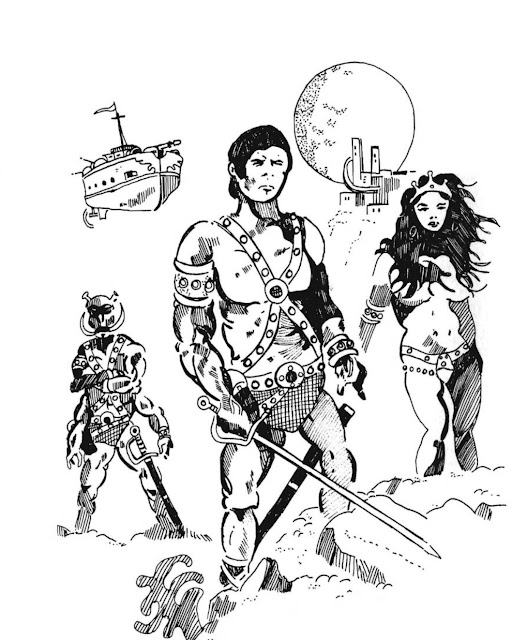Who is't hath the torch? Didst thee keepeth an account and mapeth the dreary anters?
Who is’t hath the torch?
Doth thee or thee?
Torch Markers are a neat idea I stumbled across on YouTube Dungeon Craft channel. Basically this is a visual aid that allows players and the DM to see which players are holding the torch, lantern, or other light source. I made mine out of craft wood circles, however they could be made out of a variety of materials as long as the player’s representative figurine fits on them and shows clearly the marker. There are some commercially available ones on the net too that slide onto one side of a base. Making them though is super easy.
It is really dark in caves with no light source... pitch black dark. Thus if players drop their torches, lanterns or let them burn out they will be quickly at a massive disadvantage in trying to do anything (including light a new light source). In addition light effects how far Dwarves and Elves can see. These Markers thus help everyone see who has the light source and more easily estimate what each player can see. It also stands to reason that if the adventurer holding the light source falls into a pit trap there is a chance the lantern gets broken. In addition the inhabitants of cave and dungeon systems might actively target the light bearers as a tactic to make combat easier for them. At any rate the monsters will have a heads up the party is coming because of the light. Another consideration is fighting holding a torch or lantern. Obviously a Thief or Hobbit can not hide in the shadows if they are holding the light source. No one wielding a two handed sword or bow can use them holding a lantern... in fact fighting in general will be hindered. Magic Users it must be remembered need their hands to cast spells as well. These markers help the party of players understand that the light source must be maintained and protected so the party can cooperatively survive in deep dark places or dark forests. The Markers also prevent the whole “Oh I gave the lantern to Carl the Cowardly 30 feet back before the pit trap my character Unas the Uncoordinated fell into” conversation. Players maybe forced to put the light source down, so they can defend themselves the markers then help show where the torch or lantern is.
Players may suddenly want to start hiring NPCs to carry torches... so they can fight and survive... hopefully the NPCs won’t have a morale crisis and run away with the light source when the monsters attack. The players will need to be protective of their light bearers as fighting in the dark is no good unless they are all Dwarves and Elves.
Just paint some bigger rounds (Wood, plastic or metal circular disks) yellow is the simplest way to make these. I fooled around with trying to paint light beam colors on mine.
What distance can thee see?
Per the Dungeons & Dragons Basic, Holmes 1978 edition Elves and Dwarves can see 60 feet in the dark (and so can all of the evil characters of the Dungeon Master), but Humans and Hobbits will need artificial light or be reduced to half speed or less. The rules go on to explain that Torches and Lanterns allow the players to see 30 feet, but Elves and Dwarves loose the 60 feet see in the dark if there is light within 30 feet of them. So basically a mixed party that contains Humans and or Hobbits will be limited to 30 feet of sight. Suddenly the dungeon is getting a lot more scary... how high up is the ceiling or deep that pit?
In OD&D Rules The Underworld & Wilderness Adventures Volume III all monsters are assumed to have permanent infravision as long as they are not serving the player characters. That’s right joining the ranks of the civilized adventurers means they now too need a light source to see and are limited to 30 feet.
Volumes I, II & III often refer the DM to Chainmail for additional information. According to Chainmail all Wizards aka Magic Users can see in the dark. Gnomes it is stated In Chainmail have the same abilities as Dwarves who can see in the dark.
Party order to maximize abilities might be helpful with Elves or Dwarves scouting ahead 40 feet or so and bring up the rear 40 feet or so behind the middle.
How long wilt the light last?
The Dungeons & Dragons Basic, Holmes 1978 edition states a good torch will burn for 6 turns and a flask of oil in a lantern will last 24 turns. Each standard roaming around the dungeon turn is 10 minutes so a torch can last 1 hour and a lantern 4 hours. Magical light will be subject to any spell limitations or magical item limitations.
Some Dungeon Masters solve the lighting issue or rather the running out of torches or oil issue by having glowing fungus lamps or some other naturally occurring fantasy light source. Keep in mind a strong wind or a camp of startled bats can blow a torch or lantern out (hooded lanterns offer protection against the wind and bad weather). A dropped lantern will go out, a dropped torch will keep burning.
Didst thee keepeth an account and mapeth the dreary anters?
I started playing D&D with no miniature figurines, no battle play inch grid maps, no maps ever being handed out... the DM simply described everything and asked questions as needed. As a player I learned quickly to take notes, make side maps and ask questions or one’s character Ralph the Second might quickly become Ralph the Sixteenth. Mapping was not handled by giving players graph paper, it was hard to find when I was a kid and expensive for our collective player/DM budgets. I remember we sometimes had to do our best to hand draw graph paper simply because it was not easily obtained. Graph Paper was ; and still is in my games; an artifact of great value from an ancient unknown lost civilization of Magic Users or of Divine Creation.
As a DM I never hand out detailed maps or graph paper. I let the players create their own maps based on information revealed in play on regular drawing paper (their maps rarely come out looking like the master map). Even when using terrain it is what they can see not the whole Dungeon or Town/City or Wilderness area. If I give out maps of any kind they are vague, artsy, often general known information the characters know or culture might think it knows and will contain errors the players will have to correct. In addition these maps are not cheap... PCs must buy them or find them... and not all cartographers and thus maps are of the same quality. Completely fraudulent maps of course exist as well. Folks who play with me quickly learn to designate a map maker in the group, so they hopefully don’t get lost... often the player maps made on the fly contain mistakes of the player’s own making that can create problems when the party attempts to get out of a dungeon... or back to town. NPCs can be hired to be the designated map maker in play, with a player keeping track so their PC is not walking around with a scroll and ink quill in hand instead of their sword and shield. The cartographer might be keen to go exploring so they can sell more accurate and thus more expensive maps to the merchants, nobility and royalty creating an adventure hook or business arrangement with the party. Inland maps were notoriously vague, full of fantastic and inaccurate information in the Dark Ages and thus so should the maps for PCs reflect that time period. Wandering around lost in a dungeon or vast wilderness is problematic especially if you had a map and lost it because your party let the guy with the map and map making supplies get devoured by some unthinkable monstrous creepy crawly. The importance of protecting the Map Maker/Keeper can add an interesting dynamic to the adventure. Since Cartographers can write they must be educated sufficiently to read, draw, understand mathematics of the time, and more. Any resulting death of such an NPC might be cause to arrest the party. The Cartographer’s friends and family might believe the party murdered the fine gentleman.
All to often NPCs are viewed as monster fodder but many would do valuable jobs on a real life expedition and if something happened to them the whole adventure could be in jeopardy. Just some thoughts on why some NPCs in a party need not be “fighting men”.
Happy Gaming Folks!



Comments
Post a Comment